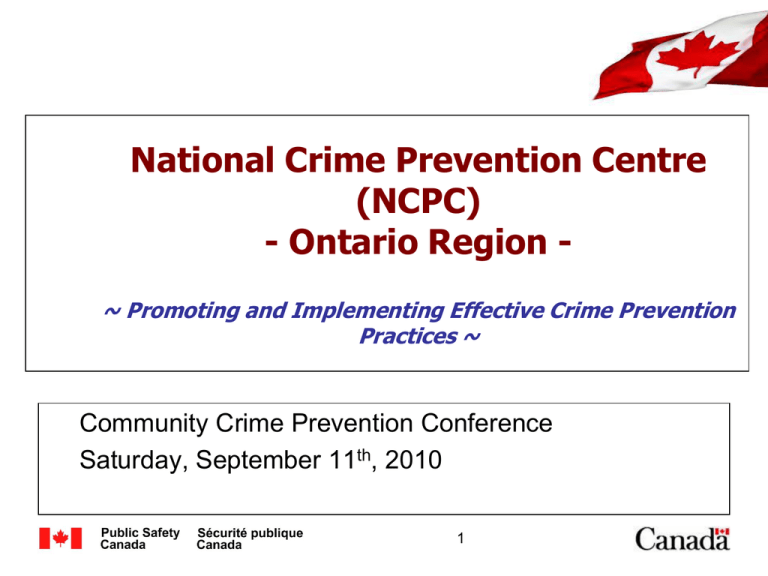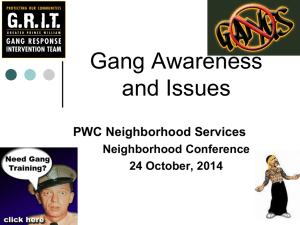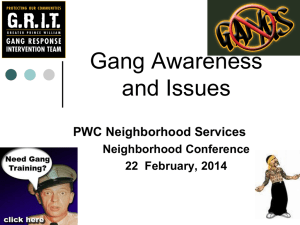National Crime Prevention Centre
advertisement

National Crime Prevention Centre (NCPC) - Ontario Region ~ Promoting and Implementing Effective Crime Prevention Practices ~ Community Crime Prevention Conference Saturday, September 11th, 2010 1 Overview of Presentation • • • • • • • • • • • Background Priorities Rationale Funding Programs Youth Gang Prevention Fund Definition of Model and Promising Program Programs for Addressing Youth Gang Involvement Ontario Projects Evaluation Strategic Work and Horizontality Application and Approval Process 2 Organization • Established in 1998 (Department of Justice/Solicitor General) • Currently within the Community Safety and Partnerships Branch in Public Safety Canada • Headquarters (NHQ) is located in Ottawa and there are 6 regional offices • Program management; policy analysis and advice; evaluation; research and knowledge dissemination • Administers the National Crime Prevention Strategy 3 Background • Public Safety Canada's National Crime Prevention Centre (NCPC) is responsible for implementing the National Crime Prevention Strategy (NCPS). NCPC: Provides national leadership on effective and cost-effective ways to prevent and reduce crime by intervening on the risk factors before crime happens Promotes the implementation of effective crime prevention practices. Works closely with partners and stakeholders in the provinces and territories to develop and implement resultsdriven programs that target specific crime issues in regions and communities across Canada. Provides communities with tools, knowledge and support to undertake crime prevention initiatives in communities large and small across Canada. 4 Priorities • Reduce offending among those most at-risk: children (aged 6 to 11), youth (aged 12 to 17) and adults (aged 18 to 24) • Supporting targeted interventions in local communities • Building and sharing practical knowledge with policy makers and practitioners • Crime prevention in Aboriginal Communities • Prevent recidivism among high-risk groups • Priority crime issues (youth gang, drug-related crimes and gun violence) 5 6 Rationale • In keeping with NCPC’s mandate, crime prevention practices should: Be integrated with the activities of existing community programs and services Build on the knowledge of risk and protective factors Use evidence-based practices Address one or more risk or protective factors associated with delinquency, substance abuse or violence Intervene at developmentally appropriate ages as it relates to priority groups established by the NCPC Be found to have positive effects on delinquency, substance abuse and violence based on evaluation Be available for implementation within the community Be measurable 7 Purpose of Evaluation for the NCPS • Builds the knowledge base of “what works” in crime prevention in Canada • Increases confidence that observed impacts can be attributed to the program • Multi-site evaluations increase knowledge about contextual factors. Can the program be effective: With different target groups (i.e. cultural settings) Within different settings (regions, economic variation) With different time periods • Increases the ability to identify what aspects of the program are contributing to the outcomes of interest (i.e. reducing violence, recidivism , drug use etc..) 8 Funding Programs • Through time-limited grants and contributions, the NCPC funds communities and organizations to assist them in developing and implementing targeted, evidence-based crime prevention initiatives • The NCPS has three streams: 1) Crime Prevention Action Fund (CPAF) 2) Northern and Aboriginal Crime Prevention Fund (NACPF) 3) Youth Gang Prevention Fund (YGPF) 9 Funding Programs • Crime Prevention Action Fund (CPAF) • Focus: Supports effective interventions to address known risk and protective factors associated with crime in order to reduce offending among at-risk children and youth, aboriginal and northern populations and high-risk offenders in communities Develops and implements knowledge transfer initiatives that focus on the application of research-based evidence to inform crime prevention practice Projects may take the form of tool and resource development, testing and dissemination, conferences, workshops, colloquiums, other training or innovative approaches to the transfer of knowledge about crime prevention 10 Funding Programs • Northern and Aboriginal Crime Prevention Fund (NACPF) • Focus: Assists communities experiencing multiple risk factors and other challenges that affect their ability to respond to crime issues, such as remote geographical location and limited capacity Supports culturally sensitive initiatives that foster the development and implementation of crime prevention approaches in Aboriginal communities, both on-and offreserve and in the North Assists in building the knowledge and capacity required to develop or adapt culturally sensitive, effective ways to prevent crime 11 Funding Programs • Youth Gang Prevention Fund (YGPF) Invests in communities where youth gangs are an existing or emerging threat and supports initiatives that clearly target youth in gangs or at greatest risk of joining gangs 12 Youth Gang Prevention Fund • The Youth Gang Prevention Fund (YGPF) was created in January 2007 to address the specific risk factors associated with youth violence and gang membership and to provide alternatives to gangs for youth • The YPGF provides time-limited funding for evidence-based promising or model prevention initiatives in communities where youth gangs are an existing or emerging threat • Under this fund, the National Crime Prevention Centre works with the provinces and territories to identify municipalities and community-based organizations that are tackling gang issues, and provides grants/contributions to support youth gang prevention 13 Youth Gang Prevention Fund • This Fund allows the NCPC to: Clearly identify the parameters for funding including the desired outcomes and the measurement of results and change for the identified risk factors Focus efforts on disseminating specific knowledge, tools and resources to Canadians so that they can plan and implement the best possible activities and approaches for gang prevention Deliver results and develop expertise on how to deal with youth gang issues by supporting rigorous third party evaluations of funded projects 14 Youth Gang Prevention Fund • 19 projects have been funded under the YGPF in cities across the country • These projects have reached over 1400 at-risk youth from communities that have been identified as having a current or emerging youth gang issue. Participants are generally between the ages of 12 to 24 • Funded projects are based on intervention models that have shown positive results in the U.S., and that have been adapted to the Canadian context. Interventions with the youth include mentorship, substance abuse prevention, and educational and job support 15 Youth Gang Prevention Fund • The 2009 Interim Evaluation Report of the Youth Gang Prevention Fund concluded that: Canada’s youth gang problem has escalated and continues to escalate At-risk youth are using the services offered through the YGPF Positive changes related to risk factors have been observed among YGPF recipients The YGPF is not being duplicated elsewhere by other levels of government, and The YGPF is in line current government priorities 16 Definitions • Model Program: A prevention program that meets the highest scientific standard for effectiveness as evidenced in published evaluations; has a significant, sustained preventive or deterrent effect or reduction of problem behaviour, the reduction of risk factors related to problem behaviour; or the enhancement of protective factors related to problem behaviour and has been replicated in different communities or settings. 17 Definitions • Promising Program: Prevention programs that meet scientific standards for effectiveness; but they do not meet all of the rigorous standards of Model programs. They are recognized and encouraged with the caution that they be carefully evaluated. In general, when implemented with minimal fidelity these programs demonstrate promising empirical findings using a reasonable conceptual framework and a limited evaluation design. 18 Programs for Addressing Youth Gang Involvement • Boston Gun Project and Operation Ceasefire Program Rating: Promising program • • Gang Prevention through Targeted Outreach / Gang Intervention through Targeted Outreach Program Rating: Promising program • • Target Population: Youth aged 6 to 18 who are at risk of gang membership OJJDP Comprehensive Gang (or "Spergel") Model Program Rating: Promising program • • Target Population: Youth aged 6 to 18 involved in gang and gun violence Target Population: Youth aged 12 to 25 involved in gangs Philadelphia Youth Violence Reduction Partnership Program Rating: Promising program • Target Population: Youth at-risk of violence under the age of 24 19 Ontario Projects • City of Toronto – Community Safety Secretariat Preventing Youth Gang Activity in Toronto OJJDP/Wraparound • Target Population: Youth at-risk of joining gangs 13 – 24; Youth engaged in gangs 13 – 24 • Durham Family Court Clinic Early Gang Intervention Program Wraparound • Target Population: Youth (12-18); Community at large • Niagara Citizens Advisory Committee Inc. Youth Options for Success – Project Y.O.S • Target Population: Youth (12-18); Community at large 20 Evaluation in the Ontario Region Type of Evaluation & Fund Projects Total # Youth Gang Prevention Fund • Process and Outcome Evaluations • Moderately rigorous • Under the contribution agreement • Durham Family Court Clinic • Living Rock Ministries • San Romanoway • Niagara Citizens Advisory Committee • City of Toronto 5 21 Strategic Work and Horizontality • • • • • • • • MOU with Province of Ontario Urban Aboriginal Strategy NADS (National Anti-Drug Strategy) Ontario Federal Council TYPPP (Toronto-area Youth Pluralism Pilot Project) Other federal departments Provincial Ministries NGOs, e.g. United Way 22 Application and Approval Process • Two-stage application process begins with requests for Letter of Intent (LOI) on the Public Safety Canada web site • LOI’s are screened for eligibility using a standardized screening tool • Applications are then completed and developed with applicants who meet the eligibility criteria • Following the review, the NCPC presents projects for consideration to the Project Review Committee (PRC) • PRC reviews and recommends proposals: The committee provides advice and recommends proposals for ministerial approval taking into consideration the objectives and priorities of the project 23 Application and Approval Process Continued… • Proposals recommended by the PRC are forwarded to the NCPC Ottawa (headquarters) office for final review and approval • Contribution agreement (or grants) are prepared and sent to recipient organizations • Agreements are managed and monitored by NCPC regional staff 24 For more detailed information on youth gang prevention projects funded by the NCPC please see the publication: Crime Prevention in Action: Youth Gang Prevention Fund www.publicsafety.gc.ca Nicola Epprecht National Crime Prevention Centre Ontario Region Nicola.Epprecht@ps-sp.gc.ca 25








